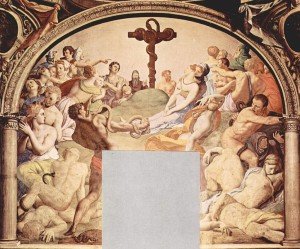RCL Lections for Sept 14th Holy Cross Day (The Lections for the 14th Sunday after Pentecost are pre-empted this Sunday for the observance of Holy Cross Day)
The strange images and metaphors that illustrate our Biblical faith never cease to fascinate me. I wonder how many of those who cite and quote John 3:16 (one of the most famous bible verses) realize that it not only refers to this strange Old Testament story but in the context shockingly Jesus identifies himself not with Moses the liberator and healer but with the snake on the stick. “And just as Moses lifted up the serpent in the wilderness, so must the Son of Man be lifted up, that whoever believes in him may have eternal life. For God so loved the world that he gave his only Son, so that everyone who believes in him may not perish but may have eternal life.” (John 3:14-16)
This not “Gentle-Jesus-Meek-and-Mild” nor is it Jesus the wandering mystic exhorting enlightenment regarding our essential unity with God. Rather the one we are to believe in is the crucified Jesus who not only looked frightful on the cross but must havc appeared helpless to help anyone else.
If we feel uneasy about comparing Jesus our hero with the replica of a poisonous snake on a pole, we should remember that the tradition of connecting snakes with health and life is broader and older than Christianity. Several ancient Egyptian goddesses were portrayed as or adorned with snakes or scorpions and were thought to protect against the poison of the same. Asclepius, a Greek deity of healing, is portrayed with a staff that has snake wrapped around it. From Asclepius’ daughters, Hygeia and Panaceia, we get the medical terms Hygiene and Panacea.

 Those interested in symbolism may have fun researching the history, confusion and controversy regarding the use of the Caduceus of Hermes and the Staff of Asclepius as medical symbols, (wiki is here) and the ongoing question of whether the Hebrews influenced the Greeks or vice versa
Those interested in symbolism may have fun researching the history, confusion and controversy regarding the use of the Caduceus of Hermes and the Staff of Asclepius as medical symbols, (wiki is here) and the ongoing question of whether the Hebrews influenced the Greeks or vice versa
Moses was instructed to put one of the fiery (snakes) that threatened the community on a pole. Apparently he used a brass replica. The Romans put criminals who were deemed to threaten society on crosses. Publicly “lifting up” an example of a defeated foe has long been intended to encourage and warn and thus protect society. However the story doesn’t present itself as a simple exhortation to greater judicial or medical efforts by the community. The divine solution was not to remove the snakes so no one was harmed but to provide a method whereby those who were sick unto death (perhaps per Kierkegaard) could be healed if they chose to be.
At first it may seem ludicrous but healing is obtained by looking toward (trusting in) something that looks like the very problem we fear and the source of poison that threatens us. But once we get over the initial strangeness, the theology of the snake on a stick is not so complicated. Although as much as it speaks of the paradox of the Cross of Christ (how on earth does an instrument of torture and death become a symbol of grace and life?) to many it continues to appear foolish. I don’t think it was a lack of generosity toward sceptics that led Paul to write “the message about the cross is foolishness to those who are perishing, but to us who are being saved it is the power of God” (1 Corinthians 1:18); rather a simple recognition that most of us are sceptical about unusual remedies until we experience being cured by them for ourselves.
I hesitate to cite the old cure for a hangover: “a little of the hair of the dog that bit you” but a similar principle is at work in the practices of immunization, inoculation and particularly in the use of anti-venom. Anti-venom contains antibodies to the poison produced by another that are then transfused into victim of the venom. The cure is composed of the curious combination of the poison and the blood of another “victim”.
We can see the spiritually analogy in a cure that has an uncanny resemblance to the sickness. Just as the snake on a stick resembled the very problem facing the people, Jesus death on the cross resembles our own problem with the threat and consequences of sin and death. “Sending his own Son in the likeness of sinful flesh, and to deal with sin, he condemned sin in the flesh,” (Romans 8:3). And just as the use of anti-venom requires the victim and caregivers to trust the cure enough to “look to it” for its life saving qualities, the gospel presents as cure for the deadly effects of sin, looking (in simple faith) to Jesus for such salvation.
But the New Testament seems to be saying even more than this about the cross. “Christ redeemed us from the curse of the law by becoming a curse for us– for it is written, “Cursed is everyone who hangs on a tree” (Galatians 3:13). “God made him who had no sin to be sin for us, so that in him we might become the righteousness of God.” (2 Corinthians 5:21, NIV). It seems we have a picture of One who absorbs the consequences of deadly poison in order to save others from death. Perhaps the honour we confer on those who sacrifice themselves in order to save others suggests we are not as troubled by this principle as many popular critiques of substitutionay atonement suggest?

